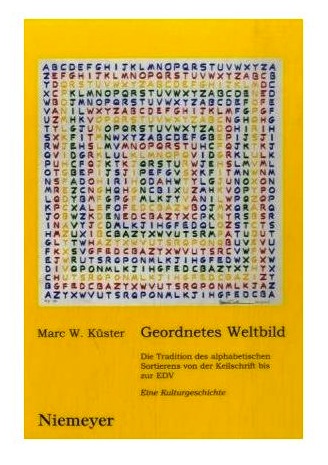Geordnetes Weltbild

Marc Wilhelm Küster: Geordnetes Weltbild. Die Tradition des alphabetischen Sortierens von der Keilschrift bis zur EDV. Eine Kulturgeschichte. Niemeyer: Tübingen, 2006 (actually January 2007) 740 pages. 58 figures. EUR 74.– / SFr 127.–, ISBN 13: 978-3-484-10899-8, ISBN 10: 3-484-10899-1
A coincidence, perhaps, but a fortunate one: On the day of the official opening of the German year of the humanities in Berlin under the title ABC of mankind my cultural history Geordnetes Weltbild. Die Tradition des alphabetischen Sortierens von der Keilschrift bis zur EDV (An Ordered View of the World. The Tradition of Alphabetic Ordering from Cuneiform to the Computer, currently available only in German) hit the library shelves. From Sumerian cuneiform lists to modern code tables, the book develops the history of our alphabet from the perspective of its character sequences and their many uses. Thus it develops a broad cultural history of the most elementary knowledge of our literacy, the alphabet – and what may seem to be so natural as the sequence A, B, C, …?
But how and why did every letter get its position in this series and how was this sequence reused and reinterpreted over and over again over the millennia?
The result is a grammatological work with many insights into linguistics, semiotics, and cultural science – a history of the ABC of Europe, “an important contribution to the cultural history of humankind” (International Review of Biblical Studies, 53, 2006/2007).
Related content:
Reviews available online:
- Review in Zeitschrift für Bibliothekswesen, 55 (2008), 2
- Review in B. I. T. online